Abstract
The nitrogenated holey two-dimensional carbon nitride () has been efficaciously utilized in the fabrication of transistors, sensors, and batteries in recent years, but lacks application in the photovoltaic industry. The possesses favorable optoelectronic properties. To investigate its potential feasibility for solar cells (as either an absorber layer/interface layer), we foremost detailed the numerical modeling of the double-absorber-layer–methyl ammonium lead iodide () –carbon nitride () layer solar cell and subsequently provided in-depth insight into the active-layer-associated recombination losses limiting the efficiency () of the solar cell. Under the recombination kinetics phenomena, we explored the influence of radiative recombination, Auger recombination, Shockley Read Hall recombination, the energy distribution of defects, Band Tail recombination (Hoping Model), Gaussian distribution, and metastable defect states, including single-donor (0/+), single-acceptor (−/0), double-donor (0/+/2+), double-acceptor (2/−/0−), and the interface-layer defects on the output characteristics of the solar cell. Setting the defect (or trap) density to with a uniform energy distribution of defects for all layers, we achieved an of 24.16%. A considerable enhancement in power-conversion efficiency () was perceived as we reduced the trap density to for the absorber layers. Furthermore, it was observed that, for the absorber layer with double-donor defect states, the active layer should be carefully synthesized to reduce crystal-order defects to keep the total defect density as low as to achieve efficient device characteristics.
1. Introduction
At present, photovoltaic modules based on wafer-based crystalline silicon solar cells account for >90% of the global photovoltaic market [1,2,3,4,5]. Laudable enhancements in power conversion efficiency () have been experienced for this technology over the last few years, leading to thin film, tandem, and various lab-based architectures [6,7,8,9,10,11,12,13]. Additionally, the manufacturing process of crystalline-based solar modules requires expensive materials and high production costs. Given that, double-absorber-layer (DAL) solar cells, rivaling the tandem solar cells, can be considered a promising candidate, among emerging photovoltaic technology, achieving a high device performance while cutting costs [14].
Despite perceptible advancements in tandem solar cells (perovskite/silicon tandem solar cells that have been reported recently, with an impressive [15]), the ease of fabricating DAL solar cells is one of the major advantages reducing complexity in tuning two-terminal tandem solar cells or managing the four-terminal tandem device circuitry. Besides this, DAL solar cells can be characterized by low production costs, compared to tandem solar cells, making them a potential candidate for the future of the photovoltaic industry [16].
The composition of DAL solar cells requires the absorber layers (or active layers) to have an almost similar lattice structure [16]. The active layers can be chalcogenides, perovskites, polymers, or other organic/inorganic layers. In such an architecture, the absorber layer with varied energy band gaps, which form the junctions sequentially, harness photo-generated power from their respective portions of the solar spectrum. This makes the multi-junction devices efficient and comparable to single-junction ones. However, the success of such DAL devices lies in the current matching of the active-layer junctions and efficient recombination of photo-generated carriers from the adjacent junctions.
To date, limited research has reported on the theoretical modeling/fabrication of DAL solar cells. Ho Yeon, Deuk, et al. [17] reported a 4% efficient PbS/Cds solar cell fabricated by chemical bath deposition. Ahmad, Faiz et al. [14] theoretically proposed an optical modeling of a absorber layer solar cell with an impressive . AlZoubi, Tariq, et al. [18] detailed a numerical modeling of a CZTS/Si-based active layer solar cell with . Maurya, K et al. [19] computationally detailed a >35% efficient thin-film device based on an /CZTS absorber layer. S Yasin et al. [16] recently detailed a absorber layer solar cell with keeping the trap density at .
Here, we proposed a novel structured DAL, employing metal halide perovskite and Carbon Nitride () as the absorber layers. Carbon Nitride () is a 2D material with a structural composition similar to graphene, with a wider energy band gap and a higher optical absorption in the visible spectrum. has been used for photocatalysis, and in the fabrication of field effect transistors FETs, biosensors, batteries, and hydrogen storing [20,21,22,23]. material has favorable properties for use as a primary absorber for photovoltaic applications. It has been numerically explored for photovoltaic cell modeling but has not yet been reported in the literature. We, therefore, focused on a defect-based study for the absorber layers, to comprehensively investigate the proposed active layered structure solar cell favorability for future thin-film photovoltaic applications.
2. Numerical Modeling and Material Parameters
The proposed solar cell is composed of FTO///SpiroOmeTAD/Au-back metal contact (see Figure 1) and was numerically modeled and investigated in SCAPS-1D, which is based on three coupled semiconductor differential equations: Poisson’s equation, and the continuity equations for electrons and holes (1) [7]. The material parameters for the simulation are enlisted in Appendix A Table A1. The SCAPS numerically evaluates the steady-state solution of these equations with appropriate boundary conditions [24,25,26,27].
where is the electrostatic potential, q is the electronic charge, and are the position-dependent hole and electron concentration, and is the position-dependent ionized dopant and acceptor concentration, is the shallow/bulk trap (or defect) carrier concentration. The electron–hole pair generation, in the absorber layer is a result of incident photon flux () of wavelength (), at each position () within the layer, and follows the mathematical relation (2) [28]. , are the minimum and maximum wavelengths of the incoming solar spectrum.
where, in
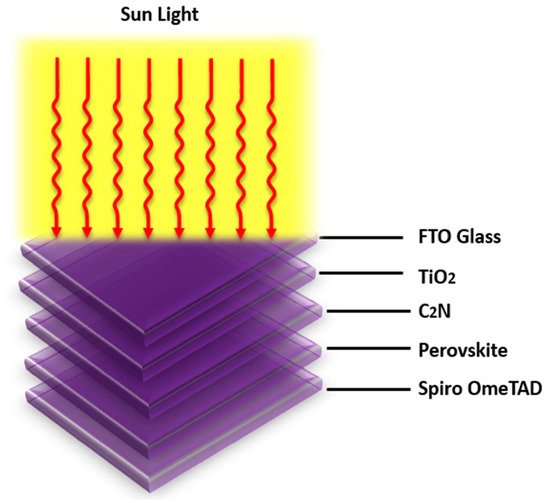
Figure 1.
Proposed double-absorber-layer solar cell-layer structure.
In the above equation, is the transmission at the front contact (wavelength-dependent), is the reflection at the back contact (wavelength-dependent), is the internal reflection at the front contact, and d is the layer thickness.
Further, we employed one of the four SCAPS inbuilt optical absorption () models following the expression (4) [28]. In this model energy band gap, follows the square root law and = 0 if the incident photon energy is .
The device with only the perovskite absorber layer demonstrated an of 23.83%, an open-circuit voltage () of 1.22 V, a short circuit current density () of 23.3418 a fill factor (FF) of 83.18%. The devices with optimized thicknesses with perovskite/ demonstrated an increased of 24.17%, an open-circuit voltage () of 1.22 V, a short circuit current density () of 23.6392 and a fill factor (FF) of 83.27%. The current density–voltage curve of the DAL solar, under standard illumination conditions, is depicted in Figure 2a. Figure 2b illustrates the energy level diagram of the solar cell. Furthermore, the external quantum efficiency of the solar cell with (see Figure 2c) remained at > 90% for the near-ultraviolet region, ( incident light or photon energy, ~3.44 eV) to the major part of the visible-light spectrum (incident light wavelengths or ~3.44 eV), clearly showing a better quantum efficiency response than a single-absorber layer. It should be noted that, in further sections, defects are simultaneously introduced/changed in perovskite/carbon nitride absorber layers for investigation into the impact of the recombination phenomenon on device performance.
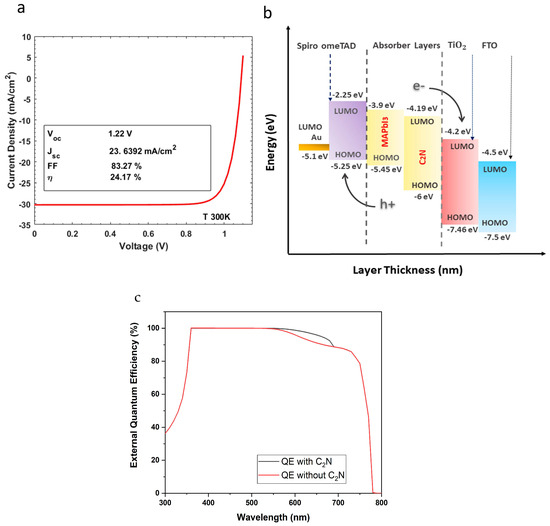
Figure 2.
The (a) current density–voltage characteristics of the solar, (b) energy level diagram of the double-absorber-layer solar cell, (c) external quantum efficiency of the solar cell with and without out carbon nitride.
3. Results and Discussion
3.1. Influence of Recombination on Device Performance
Ideally, photovoltaic material has a higher absorption coefficient to effectively harvest incident solar energy photons and convert them into free charge carriers. However, recombination losses in solar cells are inevitable due to material defects [29]. Recombination losses affect the collection current, as well as the forward-bias injection current. This directly influences the short-circuit current density and open-circuit voltage of the solar cell, thereby limiting the fill factor and efficiency of the solar cell [30]. Recombination mechanisms considered in this investigation for the / absorber layer include radiative recombination (), Auger () and Shockley Read Hall recombination (), following expression (5). More insight into the recombination phenomenon is provided in Figure 3.
where is the radiative recombination coefficient, is the Auger electron (hole) recombination coefficient, is the electron (hole) carrier concentration, () is the electron (hole) carrier lifetime, is the intrinsic energy level, is the trap energy level, and is the temperature at room temperature. The factor for as calculated by the first principles, is reported in the range of (0.5–1.5). The range of factor for perovskite material, as evaluated from time- and excitation-energy-dependent photoluminescence spectroscopy, has been reported to lie between 1.8 and 3.7. The point defect study on confirmed that such materials exhibit both a direct and indirect energy bandgap nature. We therefore set similar and factors for both the absorber layers. The device’s current density voltage characteristics under radiative, Auger, and SRH recombination are shown in Figure 4a, Figure 5a and Figure 6a, respectively.
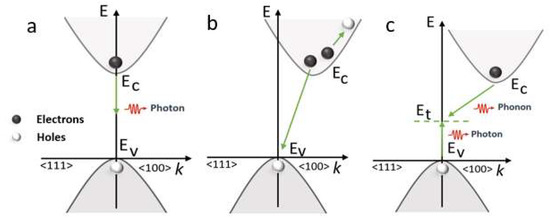
Figure 3.
Photogenerated carrier recombination mechanism. (a) Radiative recombination, (b) Auger recombination and (c) SRH recombination using energy (E) momentum (K) diagram.
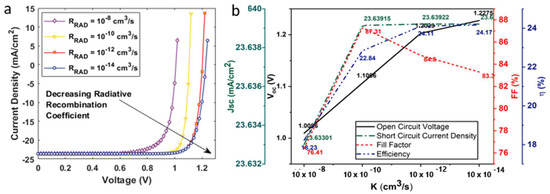
Figure 4.
(a) Current density–voltage characteristics of a solar cell under radiative recombination; (b) influence of radiative recombination on the open circuit voltage, short circuit current density, fill factor, and efficiency of the solar cell.

Figure 5.
(a) Current density–voltage characteristics of a solar cell under auger recombination; (b) influence of Auger recombination coefficient on the open circuit voltage, short circuit current density, fill factor, and efficiency of the solar cell.
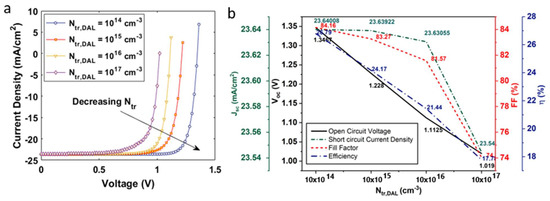
Figure 6.
(a) Current density–voltage characteristics of a solar cell under auger recombination; (b) influence of defect density-assisted SRH recombination on the open circuit voltage, short circuit current density, fill factor, and efficiency of the solar cell.
To investigate the impact of radiative recombination, we varied the factor in the range of (see Figure 4b). An increased value of has an adverse effect on the output characteristics of the solar cell. It was observed that the device demonstrated a maximum ~24.17%, , and at = as illustrated in Figure 4. The highest FF was obtained at = . The device’s fell to ~16% as we increased the to . To investigate the influence of on device performance, we varied the at (see Figure 5). The device demonstrated a maximum at = and a minimum = . To analyze , we employed the trap density model as it has been elaborated in previous studies. The trap density for the double-absorber layer, was within the range (see Figure 6). As discussed earlier, the device was simulated with a defect density of . On decreasing the defect density to , the device demonstrated a maximum ~26.18%, , and , and the device reduced to ~17%, including other device parameters, as we increased the defect density to .
3.2. Influence of Energy Distribution of Defects on the Device Performance
In organic–inorganic absorber layers, the energy distribution of defect modeling is imperative to accurately model the device. The total defect density of state (DOS) in the absorber layer is assumed to comprise shallow level defects, modeled by exponentially decaying conduction or valence band tail states, and deep-level defects modeled by Gaussian distribution in the mid-gaps (see Figure 7a) [31,32]. The Gaussian conduction/valence band tail state, and energy distribution in the SCAPS environment follow the mathematical relation (6–8) [28] where is the tap energy level, is the characteristic energy, is the width of Gaussian energy distribution, is the width of tail-like distribution, is the defect density in , and is the peak density of the energy distribution. Band tailing hampers the mobility of photo-generated carriers to a great extent by trapping and de-trapping. The () is related to the degree of disorder in crystals [33]. Experimentally reported values for perovskite material are in the range of [34].
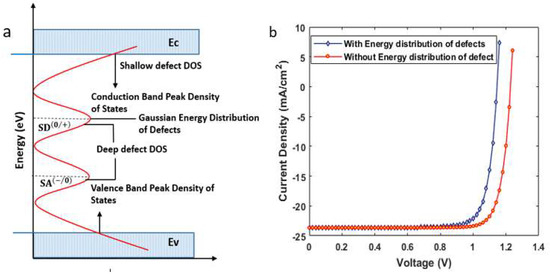
Figure 7.
(a) Density of state (DOS) of the semiconductor material; (b) current density–voltage characteristics for the solar cell with and without adoption of energy distribution of defects.
However, we kept the as 0.564 eV, while = 0.1 eV for the absorber layers. The in all the above-mentioned energy distributions is , with total defect density states of
The device was simulated with the above modeling, and current density vs. voltage characteristics are shown in Figure 7b. the device was decreased to 22.12% from 24.17%, to 1.14 V, to 23.634 , and FF as can be observed in the figure. The current density curve under both conditions is summarized in Table 1.

Table 1.
Device output characteristics with adoption of energy distribution of defects.
3.3. Influence of Metastable Defects on the Device Performance
In this section, we investigated the impact of metastable defect transition on the absorber layers. In , halide ion segregation requires the migration of halide ions, which is a defect-driven process resulting in halide vacancy defects [35]. For the absorber layer, we induced double-vacancy defects, including a single donor (), double acceptor (), double donor (), and double acceptor (), at varying total trap densities. The single (double)-donor defect states per unit of volume are concentrated closer to the conduction band edge, while single (double) acceptors are concentrated closer to the valence band [36,37]. The impact of metastable defects on device output characteristics at varied trap densities ( is summarized in Table 2, Table 3, Table 4 and Table 5. It was observed that single-donor defects affected the device output characteristics the least. However, the defect considerably affected solar cell performance in all conditions. The current density voltage characteristics for metastable state defects are depicted in Figure 8a, while Figure 8b provides more insight into the results.

Table 2.
Defect state effect on output characteristics of solar cell at trap density of .

Table 3.
Defect state effect on output characteristics of solar cell at trap density .

Table 4.
Defect state effect on output characteristics of solar cell at trap density .

Table 5.
Double donor defect state effect on output characteristics of solar cell.
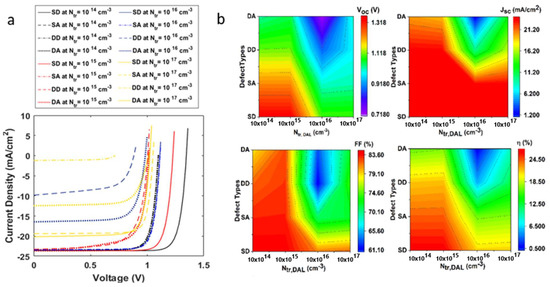
Figure 8.
(a) Current–voltage characteristics of a solar cell on inclusion of metastable defect states with varying trap densities (b) Influence of metastable defect states, single donor (SD), single acceptor (SA), double donor (DD), and double acceptor (DA), at varying defect densities, on open-circuit voltage, short-circuit current density, fill factor and efficiency of the solar cell.
3.4. Influence of Interface Defects on the Device Performance
Interfacial recombination plays a significant role in determining the performance of the solar cell. Interface defects emerge due to recombination centers at the interface of the absorber material/hole-transport layer (or electron-transport layer) [38]. These recombination centers can be present inside the absorber layer or hole-transport layer (or electron-transport layer), at the interface. Other reasons for interface defects can be an unfavorable HTL/absorber layer (or absorber layer/ETL), band alignment, and back-transfer-induced recombination [39], as illustrated in Figure 9.
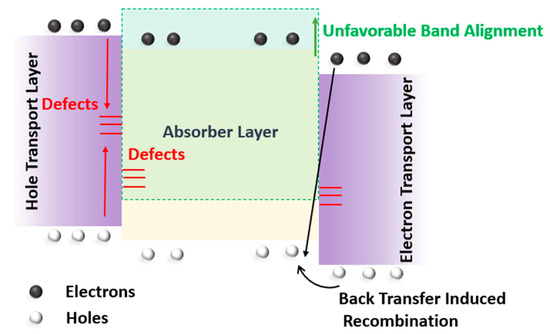
Figure 9.
Illustration of interface defects mechanism in a solar cell.
The current density–voltage curve shown in Figure 10a illustrates the effect of varying interface defect densities at the hole transport layer/absorber layer interface, . The was varied in the range of ). Interface defects considerably affected the device power conversion efficiency of the solar cell, in comparison to , as can be observed from Figure 10b. At = , the device was 23.19% and was decreased to 18.24% at = , indicating high recombination at the interface (Figure 11). Similarly, interface defect density at the absorber layer/electron transport layer interface, . was also varied in the range of ). Unlike , did not significantly affect the device performance. The device , , FF, and retained their initial optimized values at of . However, fell slightly to 23.83%, from 24.17%, on a further increase in interface defects.

Figure 10.
(a) Current voltage characteristics of solar on inclusion of interface defects at hole transport layer/absorber layer; (b) influence of interface defects on open-circuit voltage, short-circuit current density, fill factor and efficiency of the solar cell.
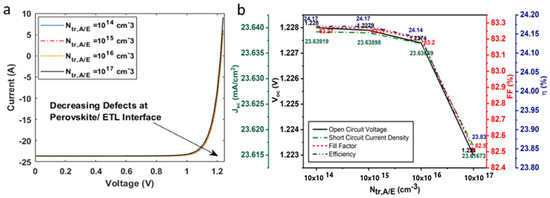
Figure 11.
(a) Current voltage characteristics of solar on inclusion of interface defects at hole transport layer/absorber layer; (b) influence of interface defects on open-circuit voltage, short-circuit current density, fill factor, and efficiency of the solar cell.
4. Conclusions
The combination of two absorber layers, carbon nitride and a perovskite absorber layer, aided in the utilization of a broader range of solar spectrum for solar energy conversion. The device demonstrated high efficiency (24.17%), open-circuit voltage (1.2 V), and fill factor (83.2%), with a uniform DOS energy bandgap. However, the focus was on the computational investigation of dominant recombination mechanisms associated with the absorber layer, to accurately investigate the device performance. The device remained > 16% under higher radiative, auger coefficient, and trap-assisted recombination. Thereafter, we modeled the Gaussian distribution energy profile for shallow-level defects and Urbach tail states for shallow-level defects. This resulted in device efficiency falling to 22.14%. Further, various double-vacancy-based metastable defect states were induced in the absorber layer. It was observed that double-donor metastable defects highly affected the performance of the solar cell. Finally, we also investigated the influence of interface defects. It was revealed that. for the proposed device architecture, increased defects in the HTL/absorber layer dominantly affected the device performance, instead of absorber-layer/ETL interface defects.
Author Contributions
Conceptualization, F.S.; Formal analysis, F.S., M.H.K., H.A.T. and S.M.S.; Funding acquisition, L.P., V.B., S.M. and N.U.; Investigation, F.S., A.H. and A.I.; Methodology, F.S., H.A.T. and A.H.; Software, F.S.; Writing—original draft, F.S.; Writing—review and editing, L.P., V.B. and N.U. All authors have read and agreed to the published version of the manuscript.
Funding
This paper received funds from the following projects: The Doctoral grant competition VSB—Technical University of Ostrava, reg. no. CZ.02.2.69/0.0/0.0/19 073/0016945 within the Operational Programme Research, Development and Education, under project DGS/TEAM/2020-017 “Smart Control System for Energy Flow Optimization and Management in a Microgrid with V2H/V2G Technology” and project TN01000007 National Centre for Energy.
Data Availability Statement
Not applicable.
Acknowledgments
This paper was supported by the following projects: The Doctoral grant competition VSB—Technical University of Ostrava, reg. no. CZ.02.2.69/0.0/0.0/19 073/0016945 within the Operational Programme Research, Development and Education, under project DGS/TEAM/2020-017 “Smart Control System for Energy Flow Optimization and Management in a Microgrid with V2H/V2G Technology” and project TN01000007 National Centre for Energy.
Conflicts of Interest
The authors declare no conflict of interest.
Nomenclature
| Efficiency | |
| Open Circuit Voltage | |
| Short-Circuit Current Density | |
| FF | Fill Factor |
| HTL | Hole transport Layer |
| ETL | Electron Transport Layer |
| DAL | Double Absorber Layer |
| Wavelength | |
| Position-dependent hole concentration | |
| Position-dependent electron concentration | |
| Shallow/bulk carrier concentration | |
| G | Electron–hole pair generation |
| Minimum wavelength | |
| Maximum wavelength | |
| Transmission at front contact dependent on wavelength | |
| Reflection at back contact dependent on wavelength | |
| Internal reflection at front contact | |
| D | Layer thickness |
| Energy bandgap | |
| Optical absorption | |
| Photon energy | |
| Radiative recombination | |
| Auger recombination | |
| Schokley Read hall recombination | |
| K | Radiative recombination coefficient |
| Auger–electron recombination coefficient | |
| Auger–hole recombination coefficient | |
| Electron concentration | |
| Hole concentration | |
| Intrinsic-carrier concentration | |
| Electron-carrier lifetime | |
| Hole-carrier lifetime | |
| Trap density of double absorber layer | |
| Characteristic energy | |
| Width of Gaussian energy distribution | |
| Width of tail-like distribution | |
| Peak density of the distribution | |
| Energy trap level | |
| Intrinsic energy level | |
| Single-donor defect states | |
| Double-donor defect states | |
| Single-acceptor defect states | |
| Double-acceptor defect states | |
| Interface defect density at hole transport layer/absorber layer interface | |
| Interface defect density at absorber layer/electron transport layer interface |
Appendix A. Layer Parameters for Numerical Modeling of Double Absorber Layer Solar Cell

Table A1.
Input layer parameters for numerical modeling of double-absorber-layer solar cell. The material parameters were adopted from the literature [16,40], as well as being self-ascribed.
Table A1.
Input layer parameters for numerical modeling of double-absorber-layer solar cell. The material parameters were adopted from the literature [16,40], as well as being self-ascribed.
| Parameters | HTL | Perovskite | Carbon Nitride | ETL | FTO |
|---|---|---|---|---|---|
| Thickness (nm) | 600 | 320 | 30 | 600 | |
| Energy bandgap, (eV) | 1.55 | 1.8 | 3.2 | 3.5 | |
| Electron affinity, χ (eV) | 3.9 | 4.2 | 4.1 | 4.0 | |
| Relative -ermittivity, | 6.5 | 4.5 | 9 | 9 | |
| Density of states at conduction band, (cm−3) | |||||
| Density of states valance band, (cm−3) | |||||
| Electron mobility, (cm2/Vs) | 1.0 × 10−4 | 2 | 12 | 330 | |
| Hole mobility, (cm2/Vs) | 2 | 20 | 50 | ||
| Acceptor concentration, (cm−3) | 0 | 0 | 0 | ||
| Donor concentration, (cm−3) | 0 | ||||
| Defect density, (cm−3) |
References
- Khalifa, S.A.; Mastrorocco, B.V.; Au, D.D.; Ovaitt, S.; Barnes, T.M.; Carpenter, A.C.; Baxter, J.B. Dynamic material flow analysis of silicon photovoltaic modules to support a circular economy transition. Prog. Photovolt. Res. Appl. 2022, 30, 784–805. [Google Scholar] [CrossRef]
- Saeed, F.; Tauqeer, H.A.; Gelani, H.E.; Yousuf, M.H.; Idrees, A. Numerical modeling, simulation and evaluation of conventional and hybrid photovoltaic modules interconnection configurations under partial shading conditions. EPJ Photovolt. 2022, 13, 10. [Google Scholar] [CrossRef]
- Mohsin, M.; Taghizadeh-Hesary, F.; Iqbal, N.; Saydaliev, H.B. The role of technological progress and renewable energy deployment in green economic growth. Renew. Energy 2022, 190, 777–787. [Google Scholar] [CrossRef]
- Yan, D.; Cuevas, A.; Michel, J.I.; Zhang, C.; Wan, Y.; Zhang, X.; Bullock, J. Polysilicon passivated junctions: The next technology for silicon solar cells? Joule 2021, 5, 811–828. [Google Scholar] [CrossRef]
- Lameirinhas, R.A.M.; Torres, J.P.N.; Cunha, J.P.d.M. A Photovoltaic Technology Review: History, Fundamentals and Applications. Energies 2022, 15, 1823. [Google Scholar] [CrossRef]
- Kim, S.; Hoang, V.Q.; Bark, C.W. Silicon-Based Technologies for Flexible Photovoltaic (PV) Devices: From Basic Mechanism to Manufacturing Technologies. Nanomaterials 2021, 11, 2944. [Google Scholar] [CrossRef]
- Saeed, F.; Gelani, H.E. Unravelling the effect of defect density, grain boundary and gradient doping in an efficient lead-free formamidinium perovskite solar cell. Opt. Mater. 2022, 124, 111952. [Google Scholar] [CrossRef]
- Saeed, F.; Waris, M.D.; Rehman, T.U.; Khan, M.A.; Khan, M.H.; Gelani, H.E. A Comparative Study of Grid-Tied PV Systems Employing CIGS and Crystalline Solar Modules. In Proceedings of the 2021 Mohammad Ali Jinnah University International Conference on Computing (MAJICC), Karachi, Pakistan, 15–17 July 2021. [Google Scholar]
- Qiao, Y.; Li, S.; Liu, W.; Ran, M.; Lu, H.; Yang, Y. Recent Advances of Rare-Earth Ion Doped Luminescent Nanomaterials in Perovskite Solar Cells. Nanomaterials 2018, 8, 43. [Google Scholar] [CrossRef]
- Mirbagheri, N.S.; Engberg, S.; Crovetto, A.; Simonsen, S.B.; Hansen, O.; Lam, Y.M.; Schou, J. Synthesis of ligand-free CZTS nanoparticles via a facile hot injection route. Nanotechnology 2016, 27, 185603. [Google Scholar] [CrossRef]
- Zhang, X.; Fu, E.; Zheng, M.; Wang, Y. Fabrication of Cu2ZnSnS4 Thin Films from Ball-Milled Nanoparticle inks under Various Annealing Temperatures. Nanomaterials 2019, 9, 1615. [Google Scholar] [CrossRef]
- Bottiglieri, L.; Nourdine, A.; Resende, J.; Deschanvres, J.-L.; Jiménez, C. Optimized Stoichiometry for CuCrO2 Thin Films as Hole Transparent Layer in PBDD4T-2F:PC70BM Organic Solar Cells. Nanomaterials 2021, 11, 2109. [Google Scholar] [CrossRef] [PubMed]
- Liu, J.; Aydin, E.; Yin, J.; De Bastiani, M.; Isikgor, F.H.; Rehman, A.U.; Yengel, E.; Ugur, E.; Harrison, G.T.; Wang, M.; et al. 28.2%-efficient, outdoor-stable perovskite/silicon tandem solar cell. Joule 2021, 5, 3169–3186. [Google Scholar] [CrossRef]
- Ahmad, F.; Lakhtakia, A.; Monk, P.B. Double-absorber thin-film solar cell with 34% efficiency. Appl. Phys. Lett. 2020, 117, 033901. [Google Scholar] [CrossRef]
- Al-Ashouri, A.; Köhnen, E.; Li, B.; Magomedov, A.; Hempel, H.; Caprioglio, P.; Márquez, J.A.; Vilches, A.B.M.; Kasparavicius, E.; Smith, J.A.; et al. Monolithic perovskite/silicon tandem solar cell with >29% efficiency by enhanced hole extraction. Science 2020, 370, 1300–1309. [Google Scholar] [CrossRef]
- Yasin, S.; Moustafa, M.; Al Zoubi, T.; Laouini, G.; Abu Waar, Z. High efficiency performance of eco-friendly C2N/FASnI3 double-absorber solar cell probed by numerical analysis. Opt. Mater. 2021, 122, 111743. [Google Scholar] [CrossRef]
- Yeon, D.H.; Mohanty, B.C.; Lee, S.M.; Cho, Y.S. Effect of band-aligned double absorber layers on photovoltaic characteristics of chemical bath deposited PbS/CdS thin film solar cells. Sci. Rep. 2015, 5, 14353. [Google Scholar] [CrossRef]
- AlZoubi, T.; Moghrabi, A.; Moustafa, M.; Yasin, S. Efficiency boost of CZTS solar cells based on double-absorber architecture: Device modeling and analysis. Sol. Energy 2021, 225, 44–52. [Google Scholar] [CrossRef]
- Mamta; Maurya, K.; Singh, V. Sb2Se3/CZTS dual absorber layer based solar cell with 36.32 % efficiency: A numerical simulation. J. Sci. Adv. Mater. Devices 2022, 7, 100445. [Google Scholar] [CrossRef]
- Mahmood, J.; Lee, E.K.; Jung, M.; Shin, D.; Jeon, I.-Y.; Jung, S.-M.; Choi, H.-J.; Seo, J.-M.; Bae, S.-Y.; Sohn, S.-D.; et al. Nitrogenated holey two-dimensional structures. Nat. Commun. 2015, 6, 6486. [Google Scholar] [CrossRef]
- Chen, Z.; Li, X.; Yang, J. The Contacts of the Monolayer Semiconductor C2N with 2D Metal Electrodes. Adv. Theory Simul. 2019, 2, 1800161. [Google Scholar] [CrossRef]
- Zhang, H.; Zhang, X.; Yang, G.; Zhou, X. Point Defect Effects on Photoelectronic Properties of the Potential Metal-Free C2N Photocatalysts: Insight from First-Principles Computations. J. Phys. Chem. C 2018, 122, 5291–5302. [Google Scholar] [CrossRef]
- Sun, J.; Zhang, R.; Li, X.; Yang, J. A many-body GW + BSE investigation of electronic and optical properties of C2N. Appl. Phys. Lett. 2016, 109, 133108. [Google Scholar] [CrossRef]
- Islam, M.S.; Sobayel, K.; Al-Kahtani, A.; Islam, M.A.; Muhammad, G.; Amin, N.; Shahiduzzaman, M.; Akhtaruzzaman, M. Defect Study and Modelling of SnX3-Based Perovskite Solar Cells with SCAPS-1D. Nanomaterials 2021, 11, 1218. [Google Scholar] [CrossRef]
- He, Y.; Xu, L.; Yang, C.; Guo, X.; Li, S. Design and Numerical Investigation of a Lead-Free Inorganic Layered Double Perovskite Cs4CuSb2Cl12 Nanocrystal Solar Cell by SCAPS-1D. Nanomaterials 2021, 11, 2321. [Google Scholar] [CrossRef] [PubMed]
- Yao, H.; Liu, L. Design and Optimize the Performance of Self-Powered Photodetector Based on PbS/TiS3 Heterostructure by SCAPS-1D. Nanomaterials 2022, 12, 325. [Google Scholar] [CrossRef] [PubMed]
- Akhtaruzzaman, M.; Shahiduzzaman, M.; Amin, N.; Muhammad, G.; Islam, M.A.; Rafiq, K.S.B.; Sopian, K. Impact of Ar Flow Rates on Micro-Structural Properties of WS2 Thin Film by RF Magnetron Sputtering. Nanomaterials 2021, 11, 1635. [Google Scholar] [CrossRef] [PubMed]
- Burgelman, M.; Decock, K.; Niemegeers, A.; Verschraegen, J.; Degrave, S. SCAPS Manual; University of Ghent: Ghent, Belgium, 2019. [Google Scholar]
- Luo, D.; Su, R.; Zhang, W.; Gong, Q.; Zhu, R. Minimizing non-radiative recombination losses in perovskite solar cells. Nat. Rev. Mater. 2019, 5, 44–60. [Google Scholar] [CrossRef]
- Riquelme, A.; Bennett, L.J.; Courtier, N.E.; Wolf, M.J.; Contreras-Bernal, L.; Walker, A.B.; Richardson, G.; Anta, J.A. Identification of recombination losses and charge collection efficiency in a perovskite solar cell by comparing impedance response to a drift-diffusion model. Nanoscale 2020, 12, 17385–17398. [Google Scholar] [CrossRef]
- Shubham; Raghvendra; Pathak, C.; Pandey, S.K. Design, Performance, and Defect Density Analysis of Efficient Eco-Friendly Perovskite Solar Cell. IEEE Trans. Electron Devices 2020, 67, 2837–2843. [Google Scholar] [CrossRef]
- Mehdizadeh-Rad, H.; Singh, J. Influence of Urbach Energy, Temperature, and Longitudinal Position in the Active Layer on Carrier Diffusion Length in Perovskite Solar Cells. ChemPhysChem 2019, 20, 2712–2717. [Google Scholar] [CrossRef]
- Belaroussi, T.; Rached, D.; Rahal, W.L.; Hamdache, F. Sensitivity of a HIT c-Si Solar Cell to Structural Distortions of the Hydrogenated Amorphous Silicon Constituting the Front Face of the Device. J. Nano-Electron. Phys. 2020, 12, 5023. [Google Scholar] [CrossRef]
- Samiee, M.; Konduri, S.; Ganapathy, B.; Kottokkaran, R.; Abbas, H.A.; Kitahara, A.; Joshi, P.; Zhang, L.; Noack, M.; Dalal, V. Defect density and dielectric constant in perovskite solar cells. Appl. Phys. Lett. 2014, 105, 153502. [Google Scholar] [CrossRef]
- Zhou, Y.; Poli, I.; Meggiolaro, D.; De Angelis, F.; Petrozza, A. Defect activity in metal halide perovskites with wide and narrow bandgap. Nat. Rev. Mater. 2021, 6, 986–1002. [Google Scholar] [CrossRef]
- Burgelman, M.; Decock, K.; Khelifi, S.; Abass, A. Advanced electrical simulation of thin film solar cells. Thin Solid Films 2013, 535, 296–301. [Google Scholar] [CrossRef]
- Ball, J.M.; Petrozza, A. Defects in perovskite-halides and their effects in solar cells. Nat. Energy 2016, 1, 16149. [Google Scholar] [CrossRef]
- Shukla, S.; Sood, M.; Adeleye, D.; Peedle, S.; Kusch, G.; Dahliah, D.; Melchiorre, M.; Rignanese, G.M.; Hautier, G.; Oliver, R.; et al. Over 15% efficient wide-band-gap Cu(In,Ga)S2 solar cell: Suppressing bulk and interface recombination through composition engineering. Joule 2021, 5, 1816–1831. [Google Scholar] [CrossRef]
- Green, M.A.; Ho-Baillie, A.; Snaith, H.J. The emergence of perovskite solar cells. Nat. Photonics 2014, 8, 506–514. [Google Scholar] [CrossRef]
- Raoui, Y.; Ez-Zahraouy, H.; Tahiri, N.; El Bounagui, O.; Ahmad, S.; Kazim, S. Performance analysis of MAPbI3 based perovskite solar cells employing diverse charge selective contacts: Simulation study. Sol. Energy 2019, 193, 948–955. [Google Scholar] [CrossRef]
Publisher’s Note: MDPI stays neutral with regard to jurisdictional claims in published maps and institutional affiliations. |
© 2022 by the authors. Licensee MDPI, Basel, Switzerland. This article is an open access article distributed under the terms and conditions of the Creative Commons Attribution (CC BY) license (https://creativecommons.org/licenses/by/4.0/).